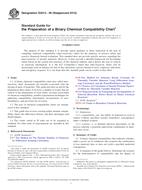Potrebujeme váš súhlas na využitie jednotlivých dát, aby sa vám okrem iného mohli ukazovať informácie týkajúce sa vašich záujmov. Súhlas udelíte kliknutím na tlačidlo „OK“.
ASTM E2012-06(2012)
Standard Guide for the Preparation of a Binary Chemical Compatibility Chart
Automaticky preložený názov:
Štandardné Sprievodca pre prípravu binárne chemickej kompatibility Chart
NORMA vydaná dňa 1.12.2012
Informácie o norme:
Označenie normy: ASTM E2012-06(2012)
Poznámka: NEPLATNÁ
Dátum vydania normy: 1.12.2012
Kód tovaru: NS-43949
Počet strán: 7
Približná hmotnosť: 21 g (0.05 libier)
Krajina: Americká technická norma
Kategória: Technické normy ASTM
Kategórie - podobné normy:
Anotácia textu normy ASTM E2012-06(2012) :
Keywords:
chemical compatibility chart, inter-reactivity chart, mixing hazards, ICS Number Code 71.020 (Production in the chemical industry)
Doplňujúce informácie
| Significance and Use | ||||||||||
|
5.1 Various United States governmental regulations forbid incompatible materials to be transported together and require that chemical reactivity be considered in process hazard and risk analysis. A chemical compatibility chart is one tool to be used to satisfy these regulations. Binary compatibility charts are useful teaching tools in general education, in the chemical plant or laboratory, and for areas and operations where commonly performed tasks might lead to chemical mixtures such as might occur during co-shipment in compartmentalized containers, storage in a common area or compositing waste. Compatibility information is essential during process hazard reviews (for example, HAZOP). These charts may provide guidance to terminal operators on DOT HM-183 that requires that materials on adjacent compartments of multicompartment tank trucks are compatible. They provide documentation that the potential for inadvertent mixing as a potential source of heat and gas evolution from chemical reactions has been considered in sizing relief devices. Compatibility charts serve as check lists for use during process hazard reviews, and the preparation of the chart itself often brings attention to potential hazards that were previously unknown. 5.2 A binary chart only considers pairs of materials and therefore does not cover all possible combinations of materials in an operation. A common third component, for example, acidic or basic catalysts, may be covered by footnoting the potential for catalysis of a reaction between otherwise compatible materials, but the form of the chart does not ensure this. There may be reactive ternary systems that will escape detection in a binary chart. 5.3 The AIChE organization Center for Chemical Process Safety (CCPS) has recommended the use of this standard in one of their recent monographs (1)5. This work is currently available for free download from: http://www.osha.gov/SLTC/reactivechemicals/index.html |
||||||||||
| 1. Scope | ||||||||||
|
1.1 A binary chemical compatibility chart also called inter-reactivity chart, documents the hazards associated with the mixing of pairs of materials. This guide provides an aid for the preparation these charts. It reviews a number of issues that are critical in the preparation of such charts: accurate assessment of chemical compatibility, suitable experimental techniques for gathering compatibility information, incorporation of user-friendliness, and provision for revisions. 1.2 The uses of chemical compatibility charts are summarized in this standard. 1.3 This guide also reviews existing public domain compatibility charts, the differences therein, and their advantages and disadvantages. 1.4 The values stated in SI units are to be regarded as standard. No other units of measurement are included in this standard. |
||||||||||
| 2. Referenced Documents | ||||||||||
|




 Cookies
Cookies
